Dog Rose, Dog Brier, Common Briar - Rosa canina
|
Rosa canina - Dog Rose, Dog Brier, Common Briar. This white to pale pink wild rose originated in Eurasia. It is been known as the Dog Rose since ancient times - reportedly Pliny the Elder, born in the time of Christ, believed that the root could cure the bite of a mad dog, and used that to explain the origin of the common name. In spite of the positive attributes of this introduced species, it can be invasive or weedy, so use caution where you let it grow.
It is found now in at least 27 states. Based on the distribution pattern, it looks to me like it was introduced on both coasts and spread toward the middle of the United States. That pattern also applies to Canada. Synonym: Rosa corymbifera
Found in:
AL, AR, CA, CT, DC, ID, IL, IN, KS, KY, MA, MD, ME, MI, MO, NC, NJ, NM, NY, OH, OR, PA, RI, TN, UT, VA, WA, WI, WV | 
Distribution of Rosa canina in the United States and Canada:

Blue=Native; Grey=Introduced
Map from USDA Plants Database:
USDA, NRCS. 2017. The PLANTS Database (http://plants.usda.gov, 08 May 2025). National Plant Data Team, Greensboro, NC 27401-4901 USA.
Search Our Database: Enter any portion of the Scientific, Common Name, or both.
Do a general Google search of the entire site:
#ad
 Follow USWildflowers on Twitter
#ad
| | Site: Kleinschmidt Grade, Adams County, ID Date: 2012-May-25 | Photographer: Gerald C. Williamson
Nikon D7000
Tamron SP 90MM f/2.8 AF Macro | | The 5 petals of R. canina are pale pink or white; from around .75 to a little over 1 inch long. The flowers may be solitary or in a corymb of a few blossoms. The leaf is odd-pinnately compound, with 5 to 7 generally mostly glabrous, toothed leaflets. The terminal leaflet may be up to 1.5 inches long, and is ovate, generally wider toward the base of the leaflet than toward the more or less acute tip. | | 
| | Site: Kleinschmidt Grade, Adams County, ID Date: 2012-May-25 | Photographer: Gerald C Williamson
Nikon D7000 | | The stigmas of Dog Rose protrude through the hypanthium orifice, but not on extended connate styles as is the case with Rosa multiflora. | | Click on the photo for a larger image
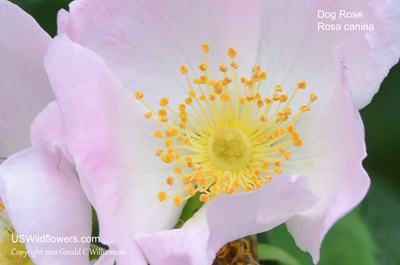
| | Site: Kleinschmidt Grade, Adams County, ID Date: 2012-May-25 | Photographer: Gerald C Williamson
Nikon D7000 | | The lobed sepals of the Rosa canina calyx are among the keys to identifying this species. | | Click on the photo for a larger image
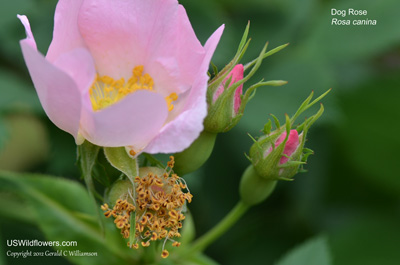
| | Site: Kleinschmidt Grade, Adams County, ID Date: 2012-May-25 | Photographer: Gerald C Williamson
Nikon D7000 | | This photo sent me on a couple-hour identification diversion; R. caninaprickles (stickers, thorns) are flattened like these, but are curved. I thought I had eliminated other species based on other features, and was starting over... Then I saw those in the next picture - whew! My rationalization for the straighter thorns is that perhaps they are on younger parts of the plant. | | Click on the photo for a larger image
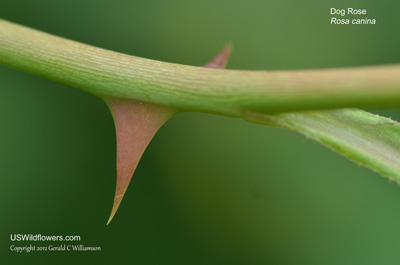
| | Site: Kleinschmidt Grade, Adams County, ID Date: 2012-May-25 | Photographer: Gerald C Williamson
Nikon D7000 | | The prickles of Dog Rose (in spite of the prior photo) are described everywhere that seems authoritative as shown here - with a distinct downward hook. | | Click on the photo for a larger image
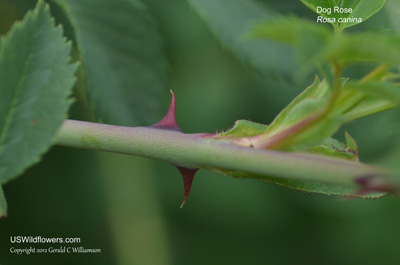
| | Site: Kleinschmidt Grade, Adams County, ID Date: 2012-May-25 | Photographer: Gerald C Williamson
Nikon D7000 | | The hips of Dog Rose are high in vitamin C, and extracts of these and the hips of other species have been used in folk medicines for a variety of treatments. The hips of R. canina are initially bright red, but stay on the plant for several months (if not eaten by birds and other wildlife) and eventually darken to black. | | Click on the photo for a larger image
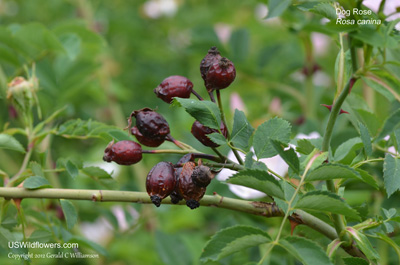
|
References used for identification and information:
|
|
| |
| #ad
|
|








